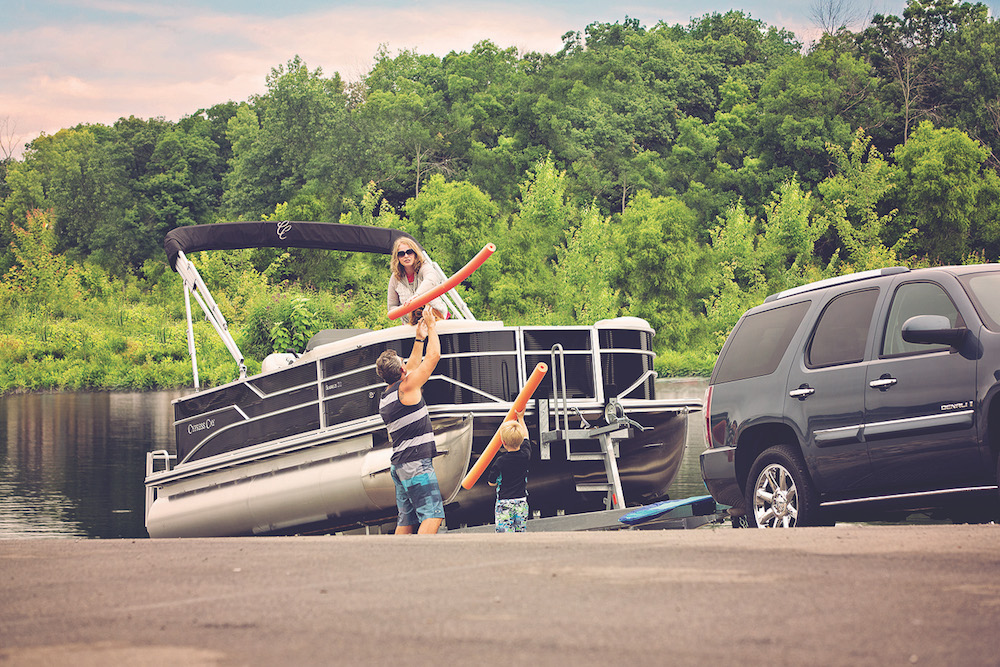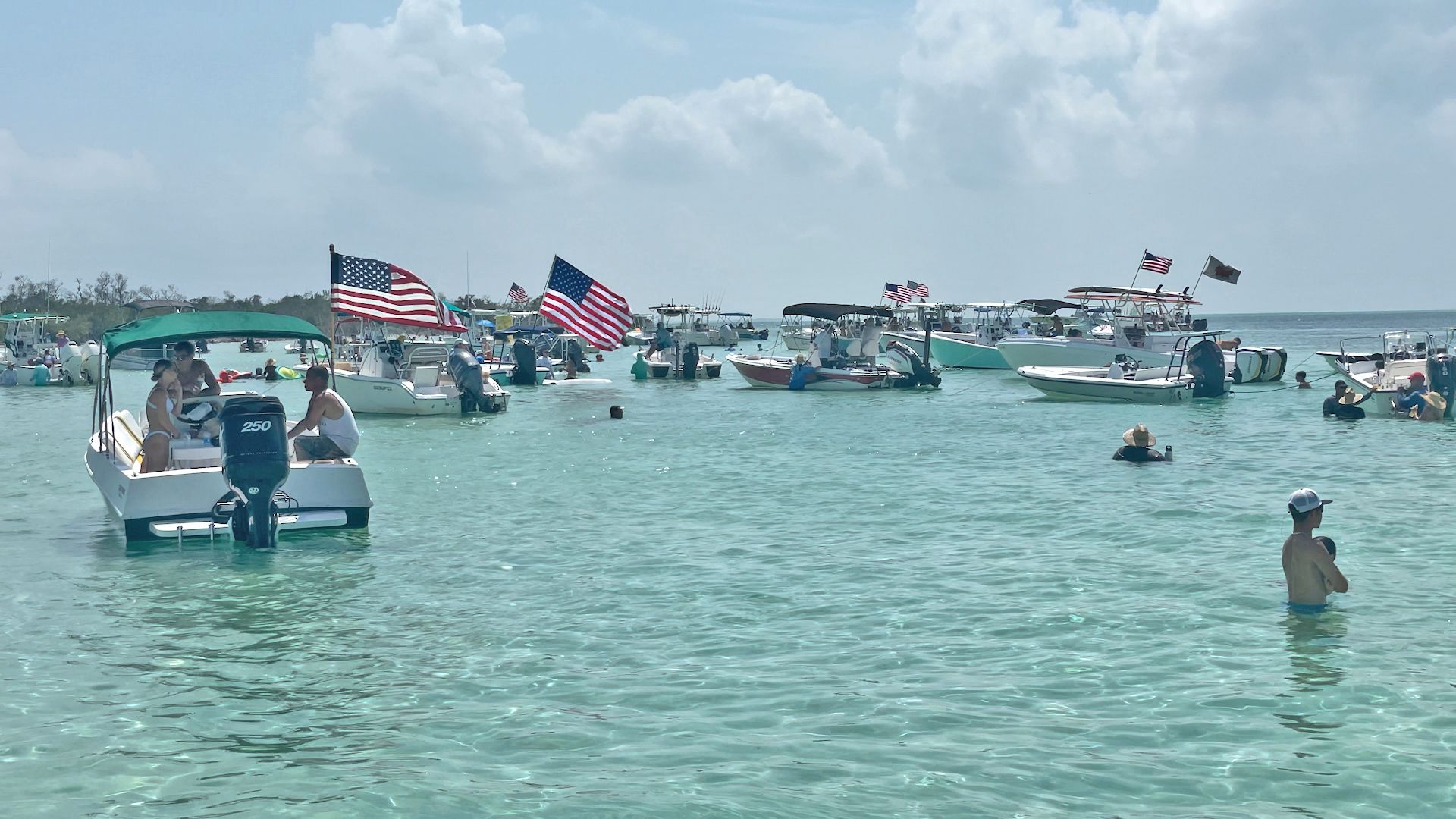Boat Safety Gear You Need Aboard to Avoid a Ticket
Boating safety gear is no laughing matter; make sure you have the appropriate items aboard your boat.
I recently tagged along with the Maryland Natural Resources Police (NRP) during a recent safety patrol to check recreational boats for proper boating safety gear. Although the specific safety gear you're required to carry varies with the size and type of your boat, the most common items of concern could be boiled down to a list of five things:
- Life jackets, properly called PFDs, or personal flotation devices
- Throwable PFDS such as throw-cushions or life rings
- Visual signaling devices, like flares
- Fire extinguishers
- Sound signals, such as an air horn or whistle (yelling doesn't count)
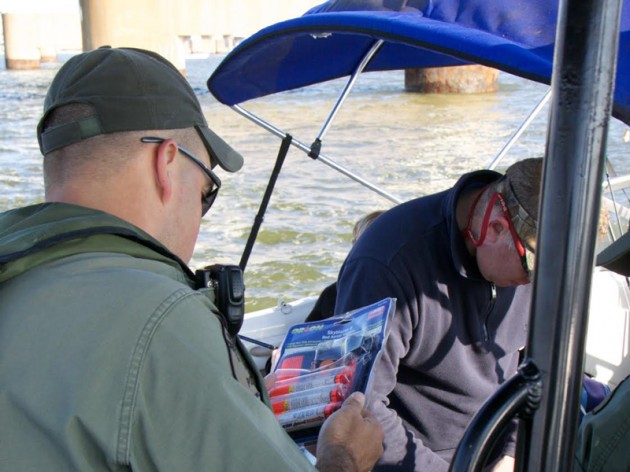
Maryland Natural Resources Police officer Chris Neville checks a boater's flares to ensure they haven't expired. Photo by Gary Reich
Luckily for all of us who enjoy the water, these encounters need not be troublesome—as long as you have the proper gear aboard. To help you comply, here's a list of the most important gear that the United States Coast Guard (USCG) requires. Additionally, your state or local municipalities may have broader regulations, such as a boater safety education requirement, so be sure to check with your local marine law enforcement agencies for details.
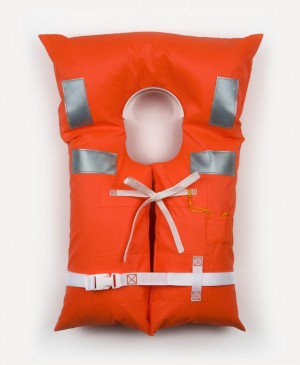
You'll need to have a personal flotation device aboard for each person, plus a throwable. Photo courtesy of Stearns
Personal Flotation Devices (PFDs)
“If there’s anything that’s a nonstarter, it’s a total lack of, or missing, personal flotation devices (PFDs),” says Candy Thomson, the NRP’s Public Information Officer, who was also onboard for our safety sortie. For pretty much every boat out there, powered or not, the USCG requires a readily accessible PFD for each person on board or being towed on water skis, etc., plus one throwable PFD. Our morning patrol was uneventful in the PFD regard, as all of the vessels we stopped and inspected were in compliance. “We’d like more of these PFDs to be accessible,” comments Ofc. Chris Neville, adding, “Having your PFDs stowed in a bag under the forward berth isn’t the best plan; they should be easy to find and put on, in the case of an emergency.”
I agree. It’s also a good idea at the beginning of each trip to have a safety briefing to inform those aboard where life jackets are located. Ahem, before you get underway.

Handheld red flares satisfy both daytime and nighttime USCG signaling requirements. Photo courtesy of Orion
Flares and Visual Distress Signals
“Oops.” That’s what the owner of a small cuddy cabin said when Ofc. Neville discovered that his handheld flares had expired more than six months ago. It was the third boat we boarded, but the first with a safety violation that day. Ofc. Neville says, “We’ll write him a warning to give him the opportunity to get those replaced. Now, if he didn’t have any onboard at all, we’d issue a citation that carries a fine.”
The USCG requires boats under 16 feet that operate at night to have signaling devices that are approved for nighttime use aboard and handheld flares generally satisfy this requirement. Boats longer than 16 feet must carry approved visual distress signals approved for daytime and nighttime use. For pyrotechnic devices (handheld or aerial red flares, orange smoke, and launchers for aerial red or parachute flares) a minimum of three are required, in any combination that totals three for daytime and three for night use. Exceptions generally include sailboats less than 26 feet that are not equipped with an engine, and human-powered (row/paddle) boats; these boats are required to carry only night signals when operating at night. Again, double-check your state requirements for additional signaling device requirements; some require daytime signaling devices on all boats.
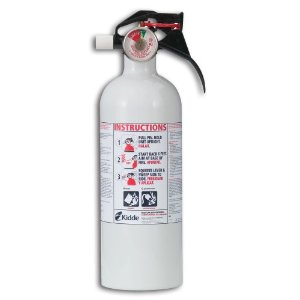
The number of fire extinguishers the USCG requires you to have aboard varies by vessel length. Photo courtesy of Kidde.
Smoke on the Water
Yes, I’m channeling the famous Deep Purple rock song in the last two entries, but smoke on the water is the last thing you want to see, especially if it is coming from your own boat. As such, the USCG requires certain boats to carry USCG-approved fire extinguishers aboard. Boats 26 feet and under with an inboard engine and personal watercraft (PWCs) must carry at least one B-1 type Coast Guard-approved portable fire extinguisher. A fire extinguisher is not required on outboard-powered boats less than 26 feet long and not carrying passengers for hire, as long as the construction of the boat will not permit the entrapment of explosive or flammable gases or vapors, and if fuel tanks are not permanently installed.
Boats 26 feet to 40 feet in length must carry at least two B-1 type approved portable fire extinguishers, or at least one B-2 type. Boats 40 to 65 feet in length must carry at least three B-1 type approved portable fire extinguishers, or at least one B-1 type plus one B-2 type. Phew, got it? Good. You’ll definitely be glad you have these devices aboard when the worst happens.

While the USCG requires anything that can produce a sounds for four seconds that can be heard a half mile away as a minimum, a portable horn like this one is far more effective than a simple whistle or bell. Photo courtesy of Falcon.
Sound Signals
The last of our four keep-you-out-of-trouble devices is a sound-making device, which is designed to attract the attention of others in the case of an emergency. For boats under 65 feet in length, this includes any item that is “an efficient sound-producing device.” This means anything from a bell, to a whistle, to a horn—portable or otherwise—but it must be capable of producing a sound that can be heard for four seconds from half a mile away. Boats longer than 39.4 feet but less than 65 feet used to be required to carry a bell, also. The USCG dropped that requirement a few years ago, but lots of informational boating websites have yet to catch up.
A few boaters we encountered on Chesapeake Bay during our patrol did not have a sound-making device aboard, which earned them a warning citation. Ofc. Ryan Colon, another NRP officer aboard that morning says, “I think the best thing to have aboard is a portable horn; they’re inexpensive, loud, and easy to stow. A whistle is legal, but I’m not sure that’s what I’d want when I need help.” I’d have to agree with Ofc. Colon.
All in all, I was impressed with how many warnings and citations we didn’t issue that morning. Most boaters we encountered on the Bay were well prepared with the required gear. Now of course this isn’t everything you need aboard, and the USCG can be particularly picky about oil and trash placards, navigation lights, and properly rigged marine sanitation devices, among other things. The best thing you can do for peace of mind is find your local Coast Guard Auxiliary and arrange for a courtesy Vessel Safety Check. These friendly folks will comb your boat from stem to stern before you get a ticket. Many state agencies offer similar services at boating safety events. Be safe out there!








